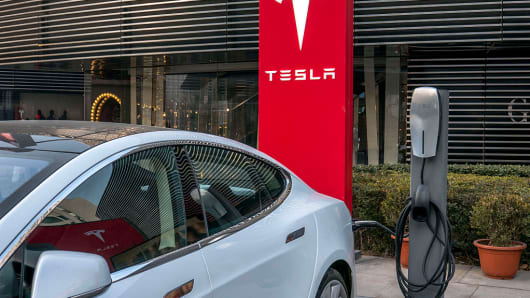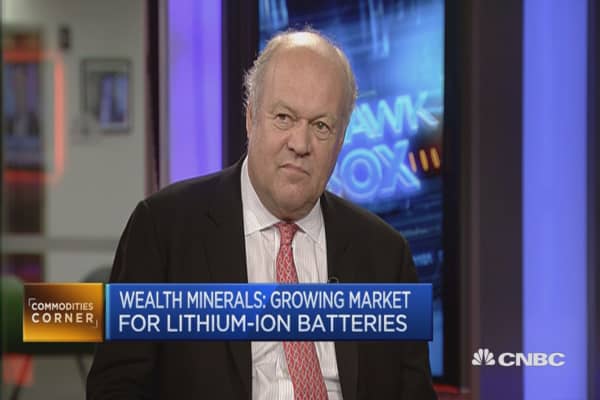Will $PFN.ca $DGO.ca $BFF.ca SX.ca supply the lithium needed to run the future’s electric cars?
Posted by admin on Dec 30, 2016 in Featured, Industry News | 0 comments

- onus is now on rechargeable batteries – rather than petrol – to propel the automotive industry into its proposed greener future, with lithium ion cells being the prevailing form of this technology.
- The automotive industry’s focus on electrification has accelerated in 2016.
Volkswagen Chairman Herbert Deiss told CNBC at the Paris Motor Show in November that “electric mobility will take off by 2020,” while Tesla CEO Elon Musk announced in May his aim for annual production to be at 1 million vehicles by this same year.
The onus is now on rechargeable batteries – rather than petrol – to propel the automotive industry into its proposed greener future, with lithium ion cells being the prevailing form of this technology.
“Lithium is a pretty abundant element naturally,” Jamie Speirs, a fellow in energy analysis and policy at Imperial College London, told CNBC via telephone. But, though worldwide production of the metal is increasing year on year, he detailed that “the current supply chain will not match up with lithium demand by, say, 2040.”
Unsurprisingly, as automakers gear up to sell more electric vehicles, prices for lithium have also risen.
“Owing to increased worldwide demand, spot lithium carbonate prices (in 2015) increased approximately 10% to 15% from those of 2014,” wrote the United States Geological Survey (USGS) in January of this year. So, which countries are crucial to lithium’s production – and who has the potential to control this market in the future? CNBC investigates.

China
Analysts CNBC spoke to concurred that China was ahead of the game in terms of its lithium production.
China’s lithium reserves are an estimated 3.2 million metric tons, according to the USGS in January 2016, meaning that the superpower ranks among those with the largest domestic supply. Most resources are located in its Qinghai and Tibet regions.
Perhaps in response to how much the market has grown – and where it may progress to in coming years – the price of Chinese battery grade lithium is currently well over $20,000/tonne, compared to $7,000/tonne in mid-2015, according to mining analysis firm CRU.
“China has a stranglehold on lithium production,” Speirs said. “Well organised and professionally run mining companies” make this enterprise profitable, he added.
This is bolstered by the convenient fact that China is the world’s largest electric vehicle market. According to the China Association of Automobile Manufacturers, sales of battery electric vehicles reached 258,000 units in the first ten months of 2016, increasing 102.5 percent year on year. In addition, the Chinese government has unveiled several incentives in recent years aimed at addressing the country’s environmental problems.
“In the future, we expect supply from China to increase significantly to meet the domestic demand,” CRU told CNBC via e-mail.
Latin America’s ‘lithium belt’
Argentina, Bolivia and Chile form a troika of lithium producers in Latin America, otherwise known as the “lithium belt” or “lithium triangle.” Could these countries spearhead a second commodity boom in the region?
“Latin American countries once produced lithium from ore, as with other metals, but can now do so from brine, which is cheaper,” Speirs explained. Contributing to the metal’s profitability, CRU added that for Latin America, “industrial-grade lithium carbonate contract prices increased by around 40% in 2016 due to strong demand growth and the ongoing supply deficit. Battery-grade lithium carbonate and lithium hydroxide prices surged higher.”
But, structural problems could hamper this particular market from taking off.

Chile, with its dry climate and lithium-rich Salar de Atacama salt flats, is an ideal production environment. The country is also popular with investors due to its free market economy. In addition, Reuters reported in November that Chilean firm SQM, one of the world’s largest lithium producers, saw 2016 third quarter profits more than quadruple due to rising lithium prices.
But, CRU told CNBC via e-mail that, “the [Chilean] industry is facing serious issues such as [the] imposition of production quota, on-going labour disputes [and] water shortage.”
Bolivia, though boasting 9 million metric tons in lithium resources, has suffered from a lack of exploration, infrastructure and technology, according to CRU. But, the Bolivian government is looking to establish a more foreign investment-friendly environment to encourage the growth of its lithium mining industry.
Unwinding Argentina’s formerly protectionist economy has been a key goal of President Mauricio Macri, which could foreground the country’s role in the lithium supply market. “Abolition of export duty on value-added products and capital controls have encouraged lithium players to consider Argentina for investment destination,” CRU told CNBC via e-mail.
Australia
According to the USGC in January of this year, Australia’s estimated reserves sit at 1.5 million metric tons. By way of contextualizing this figure, CRU said that “in 2015, Australia was the largest producer of lithium and accounted for around 40% of global lithium supply.”
It added that lithium production capacity will increase, meaning that the country is expected to maintain its position as one of the largest lithium producers in the long term.
Location is key for Australia, as CRU explained that the country enjoys investment from “downstream players such as battery manufacturers in Asian countries.” Considering that lithium is not currently traded on any major commodities or futures exchanges, shoring up future supply is crucial.
Follow CNBC International on Twitter and Facebook.
Source: http://www.cnbc.com/2016/12/30/the-new-opec-who-will-supply-the-lithium-needed-to-run-the-futures-electric-cars.html





